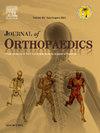Impact of anterior controllable antedisplacement and fusion (ACAF) on cervical lordosis and sagittal alignment in OPLL: A comparative radiographic analysis
IF 1.5
Q3 ORTHOPEDICS
引用次数: 0
Abstract
Purpose
The conventional anterior method for addressing multi-segmental severe ossification of cervical posterior longitudinal ligament (OPLL) is challenging and carries significant risks. Anterior controllable antedisplacement and fusion (ACAF) is a novel surgical technique for the treatment of cervical OPLL. This study aims to assess the enhancement and preservation of cervical lordosis and sagittal alignment following ACAF for patients with multi-segmental severe cervical OPLL.
Methods
A total of 69 patients with multi-segmental severe cervical OPLL were enrolled, of whom 44 patients underwent ACAF, and 25 underwent traditional anterior cervical corpectomy and fusion (ACCF). Preoperative, postoperative, and the final follow-up radiographs were utilized to evaluate improvements in cervical lordosis and sagittal alignment among patients. The following parameters were measured: C0–2 lordosis, C2–7 lordosis, segmental coriander, C2–7 sagittal vertical axis (SVA), T1 slope, thoracic kyphosis, lumbar lordosis, sacral slope, pelvic tilt, and Japanese Orthopedic Association (JOA) scores. Subgroup analyses were conducted for 21 patients undergoing single-level ACAF and 23 patients undergoing ACAF more than two levels. Additionally, outcomes for patients treated with single-level ACAF were compared with those who received single-level ACCF.
Results
At the final following-up, patients receiving ACAF had improved C0-2 lordosis, C2-7 lordosis, segmental coriander and C2-7 SVA (all p values < 0.05). The C2-7 lordosis of patients from the ACAF group more than two levels was much better than those with single level. Although the improved segmental coriander postoperatively decreased at the final follow-up, the final segmental coriander of the patients in single-level ACAF group was much better than those in two or more level ACAF.
Conclusion
ACAF showed better therapeutic effects on the enhancement and preservation of cervical lordosis and sagittal alignment in patients with multi-segmental cervical OPLL.
前路可控前移位和融合(ACAF)对OPLL颈椎前凸和矢状位对齐的影响:比较放射学分析
目的采用传统的前路手术治疗颈椎后纵韧带多节段严重骨化是一种具有挑战性和危险性的手术方法。前路可控前移位融合术(ACAF)是一种治疗颈椎上睑下垂的新手术技术。本研究旨在评估对多节段严重颈椎前凸移位患者行acf后颈椎前凸和矢状位对齐的增强和保护。方法选择69例多节段重度颈椎OPLL患者,其中44例行acf, 25例行传统颈椎前路切除融合术(ACCF)。术前、术后和最后随访x线片用于评估患者颈椎前凸和矢状位对齐的改善情况。测量以下参数:c2 - 2前凸、C2-7前凸、节段香菜、C2-7矢状垂直轴(SVA)、T1坡度、胸后凸、腰椎前凸、骶骨坡度、骨盆倾斜和日本骨科协会(JOA)评分。对21例接受单级ACAF的患者和23例接受2级以上ACAF的患者进行亚组分析。此外,比较单级acf治疗的患者的结果。结果最终随访时,接受ACAF的患者c3 -2前凸、C2-7前凸、节段香菜和C2-7 SVA均有改善(p值均为<;0.05)。两节段以上ACAF组患者的C2-7前凸明显优于单节段组。虽然术后改良的节段香菜在最终随访时有所减少,但单节段香菜组患者的最终节段香菜明显优于双节段以上的患者。结论acaf对多节段颈椎前凸和矢状位排列的增强和保存有较好的疗效。
本文章由计算机程序翻译,如有差异,请以英文原文为准。
求助全文
约1分钟内获得全文
求助全文
来源期刊

Journal of orthopaedics
ORTHOPEDICS-
CiteScore
3.50
自引率
6.70%
发文量
202
审稿时长
56 days
期刊介绍:
Journal of Orthopaedics aims to be a leading journal in orthopaedics and contribute towards the improvement of quality of orthopedic health care. The journal publishes original research work and review articles related to different aspects of orthopaedics including Arthroplasty, Arthroscopy, Sports Medicine, Trauma, Spine and Spinal deformities, Pediatric orthopaedics, limb reconstruction procedures, hand surgery, and orthopaedic oncology. It also publishes articles on continuing education, health-related information, case reports and letters to the editor. It is requested to note that the journal has an international readership and all submissions should be aimed at specifying something about the setting in which the work was conducted. Authors must also provide any specific reasons for the research and also provide an elaborate description of the results.
 求助内容:
求助内容: 应助结果提醒方式:
应助结果提醒方式:


